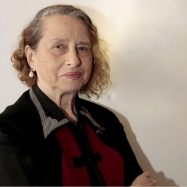
Anna Bella Geiger has a degree in Anglo-Germanic languages from the National School of Philosophy of the Federal University of Rio de Janeiro (UFRJ). She graduated from the university in the early 1950s, about the same time when she began studying art at Fayga Ostrower’s studio. In 1954, her academic training expanded to New York, where she studied Art History and Sociology of Art at New York University (NYU) and at the New School for Social Research (NSSR). After returning to Brazil, she participated, between 1960 and 1965, in the metal etching studio of the Museum of Modern Art in Rio de Janeiro (MAM Rio). Geiger’s debut in professional art was in 1953, at the 1ª Exibição Nacional de Arte Abstrata (1st National Exhibition of Abstract Art), organized by MAM Rio, at the Quitandinha Hotel, in Petrópolis (RJ). In 1962, she won an award granted by Casa de Las Américas, in Havana.
Highlights of her long and far-reaching career include several international biennial art exhibitions, such as the Bienal de São Paulo and the Venice Bienniale. From her first solo show in Toronto in 1954 to her most recent ones, she has regularly taken part in prominent group exhibitions. The exhibition Video Art (1975, Museum of Contemporary Arts, Chicago and The Institute of Contemporary Art, Philadelphia, both in the USA) proved to be a pivotal platform for her pioneering work with media. Her work is held in major collections including those of the MoMA (New York), Centre Georges Pompidou (Paris), Tate Modern and Victoria and Albert Museum (London), Getty Center (Los Angeles), and Fogg Museum at Harvard University (Boston).
As well as a distinguished artist, Anna Bella Geiger is also an author. She collaborated with the renowned art critic and philosopher Fernando Cocchiarale in the book Abstracionismo geométrico e informal: a vanguarda brasileira nos anos 50 (Geometric and informal abstractionism: the Brazilian vanguard in the 1950s), published in 1987 by Funarte, Rio de Janeiro.
Geiger’s experiments in performance art emerged from her interest in immersive installations and her dedication to socially engaged and politically responsive art. In 1972, she created at the MAM Rio (Rio de Janeiro Museum of Modern Art) what she called Ambiente Parcial (Partial Environment). Her first video installation is from 1978 (O pão nosso de cada dia, Centro Cultural Cândido Mendes, Rio de Janeiro). For decades, her career was split between between working on her own production and her passion for teaching. She continues to teach at the Higher Institute for Fine Arts – HISK (Ghent) and at Escola de Artes Visuais do Parque Lage (School of Visual Arts of Parque Lage) (Rio de Janeiro).